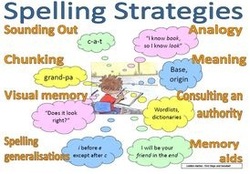Words of the Week: #3
Words of the Week: #3
1) Interactive Writing- grounded in cognitive and sociocultural theories of learning. The cognitive processes are situated and developed within a writing activity that is socioculturally constructed by teacher and students. The purpose of interactive writing is to mediate students' understanding of what it means to write. Lessons are how-to oriented; teachers model what students are expected to do during independent writing. The lesson begin with the teacher and students collaboratively planning the text they will write, often revising the oral message several times. Then, the teacher and students "share the pen" to write the oral message on a large writing tablet, word by word.
(Williams, Cheri. "Learning to Write with Interactive Writing Instruction". The Reading Teacher, vol.71, no.5, 2017, pp.523-532.)
Interactive writing is important because it helps younger students learn how to write. They get time to really work on improving their writing skills. The teacher helps them write sentences and how to correctly punctuate and capitalize those sentences. It shows students steps on how to properly write a paper, letter, etc. It's a chance for them to work together with the teacher before they are ultimately left to write sentences independently.
 Photo: https://i.ytimg.com/vi/xJ3fxOB6ulM/maxresdefault.jpg
Photo: https://i.ytimg.com/vi/xJ3fxOB6ulM/maxresdefault.jpg
2) Orthography- the ways in which letters and letter patterns in words represent sound and meaning. It focuses mainly on spelling, but it may include concepts of print.
(Bear, Donald R., et al. Words their Way. 7th ed., Pearson, 2020.)
(Williams, Cheri. "Learning to Write with Interactive Writing Instruction". The Reading Teacher, vol.71, no.5, 2017, pp.523-532.)
It's important because orthography lessons help students learn how to write properly. It shows them how to space their words, spell, etc. Students won't be able to become good writers if they don't know how to do those things. They have to have daily practice, so they truly grasp what is being taught to them.
 Photo: https://rantinglinguist.files.wordpress.com/2012/06/orthography-spelling-chart.png
Photo: https://rantinglinguist.files.wordpress.com/2012/06/orthography-spelling-chart.png
3) High Frequency Words- words that make up roughly fifty percent of any text----those that occur most often (e.g., the, was, were, is).
(Bear, Donald R., et al. Words their Way. 7th ed., Pearson, 2020.)
High frequency words are important because they are words that are very common in the texts that children and adults read. They appear very often, so students need to be able to recognize them immediately once they see them in the text. This will help to promote fluency.

Photo:
https://i.ebayimg.com/images/i/321693854289-0-1/s-l1000.jpg
4) Word Solving- involves different strategies for spelling a word. For example, saying the word slowly to hear the sounds.
(Williams, Cheri. "Learning to Write with Interactive Writing Instruction". The Reading Teacher, vol.71, no.5, 2017, pp.523-532.)
Word solving is essential to students who are young and learning how to write and spell words. It's important to teach because it will enable them to use different strategies to figure out how to spell that word. Not all strategies may work for certain students, so it's important for teachers to teach multiple word solving strategies that can cater to every student.

Photo: http://kellyandnikitaliteracyresource.weebly.com/uploads/1/1/6/8/11687817/2107039.jpg
 Photo: https://i.ytimg.com/vi/xJ3fxOB6ulM/maxresdefault.jpg
Photo: https://i.ytimg.com/vi/xJ3fxOB6ulM/maxresdefault.jpg2) Orthography- the ways in which letters and letter patterns in words represent sound and meaning. It focuses mainly on spelling, but it may include concepts of print.
(Bear, Donald R., et al. Words their Way. 7th ed., Pearson, 2020.)
(Williams, Cheri. "Learning to Write with Interactive Writing Instruction". The Reading Teacher, vol.71, no.5, 2017, pp.523-532.)
It's important because orthography lessons help students learn how to write properly. It shows them how to space their words, spell, etc. Students won't be able to become good writers if they don't know how to do those things. They have to have daily practice, so they truly grasp what is being taught to them.
 Photo: https://rantinglinguist.files.wordpress.com/2012/06/orthography-spelling-chart.png
Photo: https://rantinglinguist.files.wordpress.com/2012/06/orthography-spelling-chart.png3) High Frequency Words- words that make up roughly fifty percent of any text----those that occur most often (e.g., the, was, were, is).
(Bear, Donald R., et al. Words their Way. 7th ed., Pearson, 2020.)
High frequency words are important because they are words that are very common in the texts that children and adults read. They appear very often, so students need to be able to recognize them immediately once they see them in the text. This will help to promote fluency.

Photo:
https://i.ebayimg.com/images/i/321693854289-0-1/s-l1000.jpg
4) Word Solving- involves different strategies for spelling a word. For example, saying the word slowly to hear the sounds.
(Williams, Cheri. "Learning to Write with Interactive Writing Instruction". The Reading Teacher, vol.71, no.5, 2017, pp.523-532.)
Word solving is essential to students who are young and learning how to write and spell words. It's important to teach because it will enable them to use different strategies to figure out how to spell that word. Not all strategies may work for certain students, so it's important for teachers to teach multiple word solving strategies that can cater to every student.

Photo: http://kellyandnikitaliteracyresource.weebly.com/uploads/1/1/6/8/11687817/2107039.jpg


Comments
Post a Comment